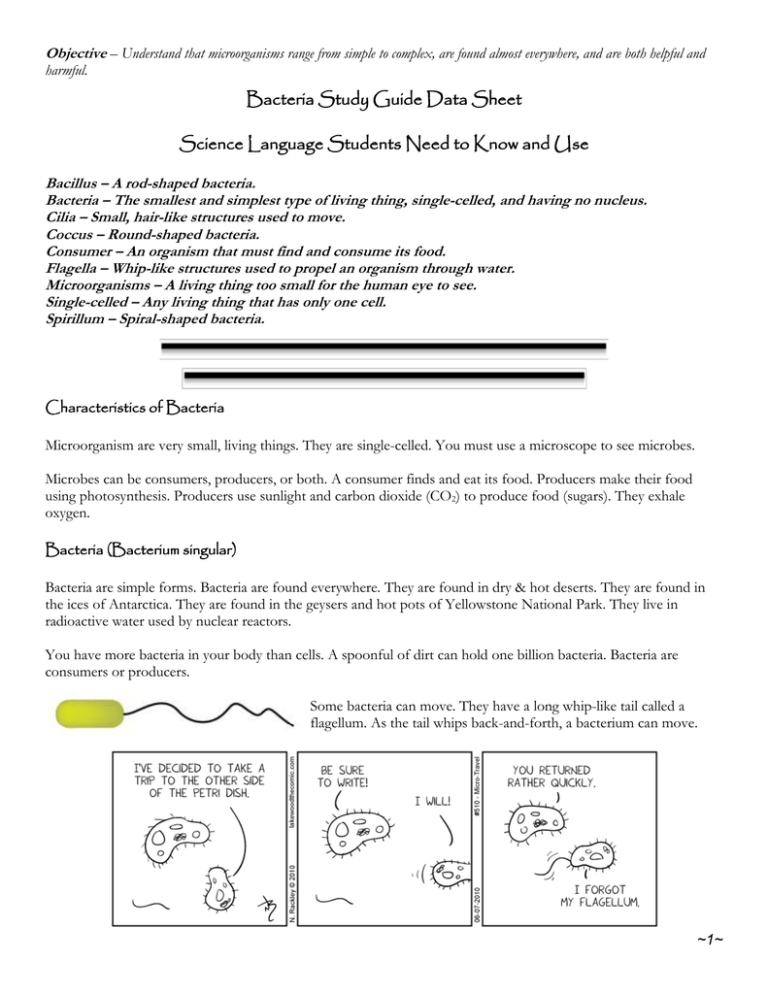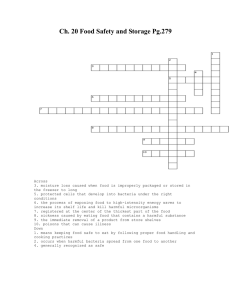Bacteria Study Guide Data Sheet
advertisement

Objective – Understand that microorganisms range from simple to complex, are found almost everywhere, and are both helpful and harmful. Bacteria Study Guide Data Sheet Science Language Students Need to Know and Use Bacillus – A rod-shaped bacteria. Bacteria – The smallest and simplest type of living thing, single-celled, and having no nucleus. Cilia – Small, hair-like structures used to move. Coccus – Round-shaped bacteria. Consumer – An organism that must find and consume its food. Flagella – Whip-like structures used to propel an organism through water. Microorganisms – A living thing too small for the human eye to see. Single-celled – Any living thing that has only one cell. Spirillum – Spiral-shaped bacteria. Characteristics of Bacteria Microorganism are very small, living things. They are single-celled. You must use a microscope to see microbes. Microbes can be consumers, producers, or both. A consumer finds and eat its food. Producers make their food using photosynthesis. Producers use sunlight and carbon dioxide (CO2) to produce food (sugars). They exhale oxygen. Bacteria (Bacterium singular) Bacteria are simple forms. Bacteria are found everywhere. They are found in dry & hot deserts. They are found in the ices of Antarctica. They are found in the geysers and hot pots of Yellowstone National Park. They live in radioactive water used by nuclear reactors. You have more bacteria in your body than cells. A spoonful of dirt can hold one billion bacteria. Bacteria are consumers or producers. Some bacteria can move. They have a long whip-like tail called a flagellum. As the tail whips back-and-forth, a bacterium can move. ~1~ Objective – Understand that microorganisms range from simple to complex, are found almost everywhere, and are both helpful and harmful. Some have hair-like structures called cilia. These beat back-and-forth allowing the bacterium to move. Bacteria come in three shapes. Bacillus – Rod-shaped Coccus – Round Spirillum – Spiral-shaped Harmful Bacteria Ask people if they could get rid of bacteria, would they? Most would say yes. We know that would not be a good decision. We can’t live without bacteria. Less than 1% of bacteria are harmful. They can be annoying. They can also kill us. How do we get sick? There are three ways. Through air. You inhale germs. Through touch. For example, if a person doesn’t wash their hands after going to the bathroom, they leave germs on whatever they tough. There could be germs on everything you touch. Eating contaminated food. Food must be cooked properly. Food must be stored properly. If it isn’t, you could get sick from bacteria growing on the food. What are examples of diseases caused by bacteria? Dental caries. You call this disease a different name. You call it cavities. It is caused by Lactobacillus acidophilus1 and Streptococcus mutans.2 It is treated by your dentist with painful drilling! Strep throat. When you have strep throat, the back of your throat is very sore. Your throat and tonsils also swell. It is caused by Streptococcus pyogene. It is a contagious disease. It is treated with antibiotics. Salmonella. Also called food poisoning. It is caused by Salmonella enteritidis bacteria among others. It can cause vomiting, diarrhea, and nausea. It is not contagious. Typhoid fever. It is caused by Salmonella typhi. It has been known kill the patient. One symptom is high fevers (102o F. to 104o F.). You get it by drinking untreated water. How can we prevent/treat disease? Vaccination. A vaccination can give you immunity to the disease. Antibiotics. 1 2 Lactobacillus – a rod-shaped bacterium (bacillus). Streptococcus – a round bacterium (coccus). ~2~ Objective – Understand that microorganisms range from simple to complex, are found almost everywhere, and are both helpful and harmful. Wash your hands after using the bathroom.3 Always wash your hands when they are dirty. Cook food properly. Store food properly. Contaminated food can lead to food poisoning. Undercooked meats are can have bacteria. You can prevent food poisoning by cooking meat properly. Hamburger and chicken must reach 160o F. in the middle for one minute. The heat will kill all harmful bacteria. Harmful bacteria will grow in food not put in the refrigerator. It should be put in within one hour of preparation. Food left out longer may have harmful bacteria. Benefits of Bacteria If they could, many people would do away with bacteria. This would not be a good thing. In fact, it would be deadly. We can’t survive without bacteria. Could bacteria survive without us? Yes. They don’t need us. We need them. When you’re hungry, you eat. The food is digested. Your body uses the digested to keep it working. What if there were no bacteria? The food would not be digested. Your body couldn’t use it to live. You would die. Why? Your intestines are full of bacteria. When food enters the intestines, bacteria break down the food. Your body can now use the food. Your body operates using the changed food. When the body is done digesting food, the only thing left is waste. Your body cannot use the left over waste. Bacteria in your intestines make Vitamin K. Vitamin K is needed to make your blood clot. Bacteria are used to benefit us in many different ways. 3 They provide chemicals. They make drugs to treat diseases like diabetes. They are used to make antibiotics. They are used to make vaccines. They are decomposers. They break down dead things. They recycle nutrients used by other living things. Bacteria are used to make foods… o Artificial Sweeteners o Butter o Buttermilk o Cheeses o Chocolate o Corn Syrup o Ketchup o Olives o Pickles o Salad Dressings o Sauerkraut Nicholas Bakalar wrote, “There is [certain] evidence that washing hands … is very effective in preventing the spread of disease…” ~3~ Objective – Understand that microorganisms range from simple to complex, are found almost everywhere, and are both helpful and harmful. o o o o Sour cream Soy sauce Vinegar Yogurt ~4~

